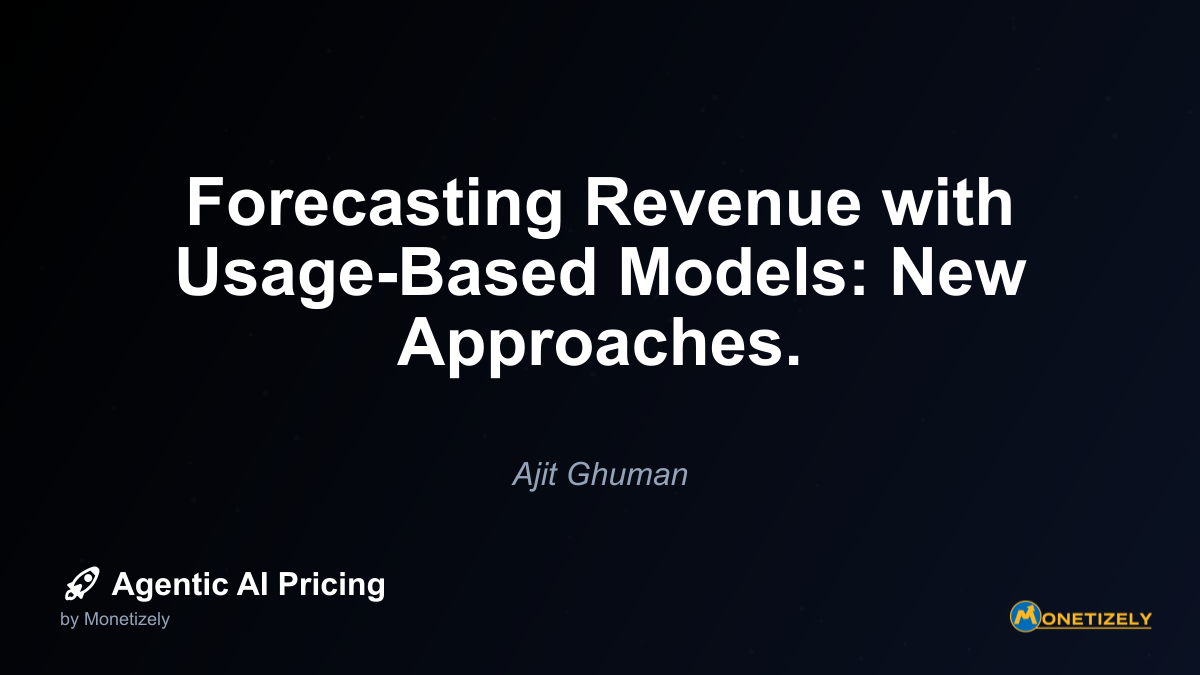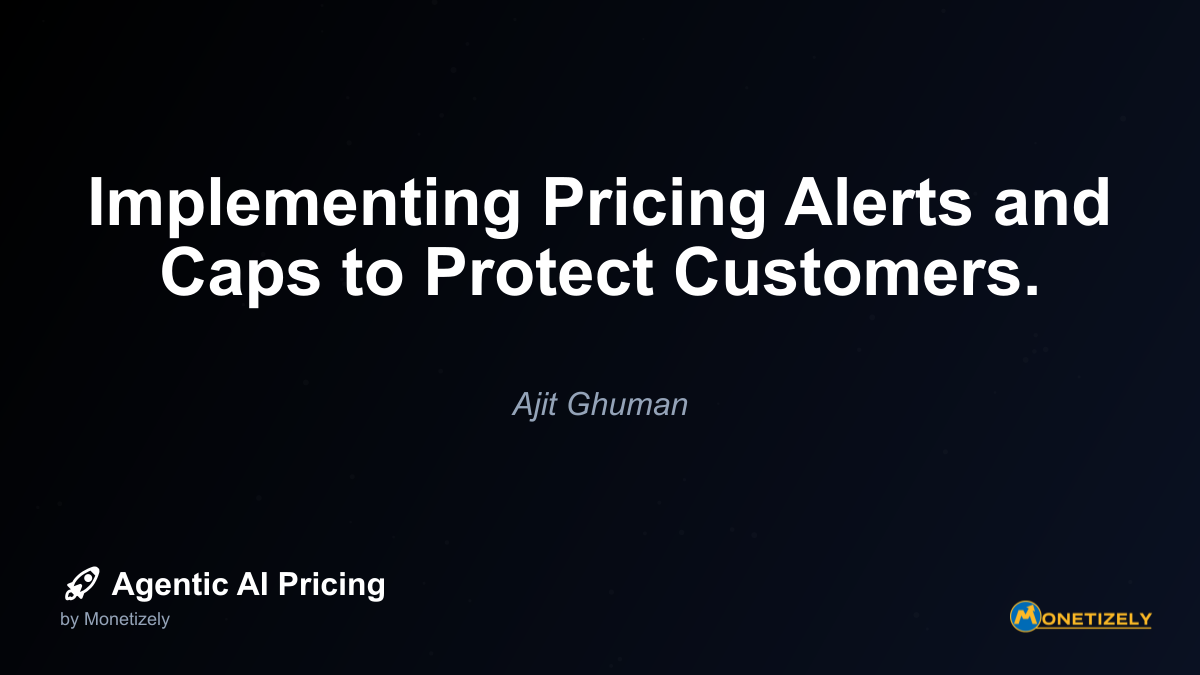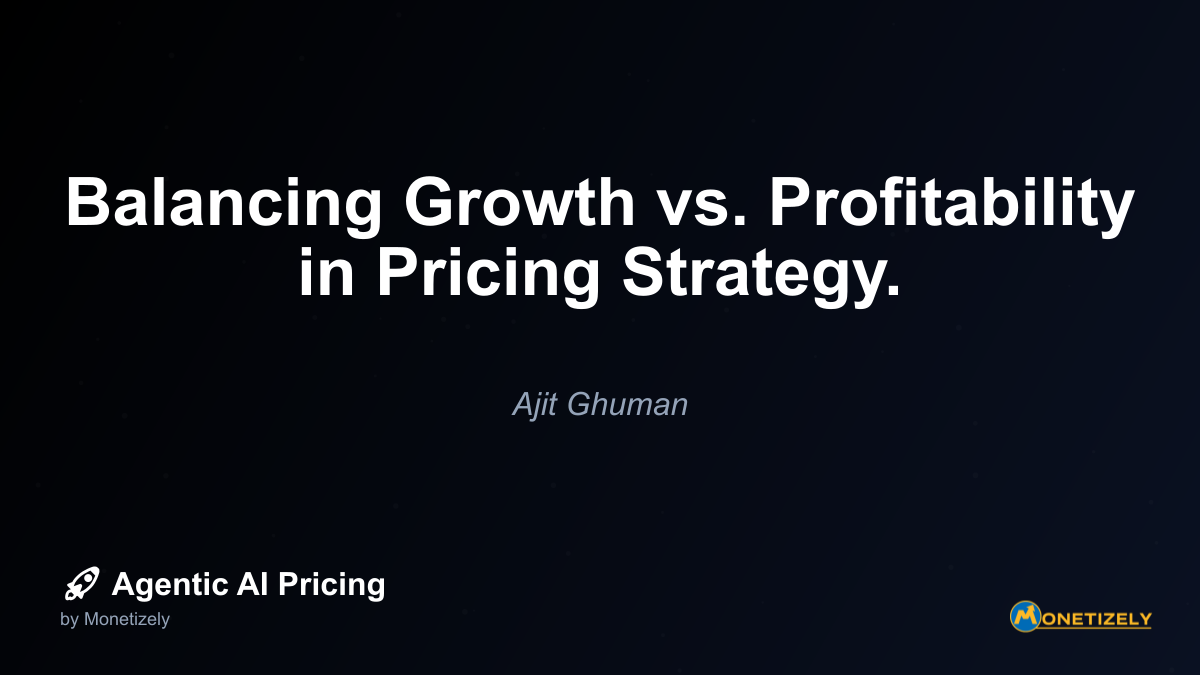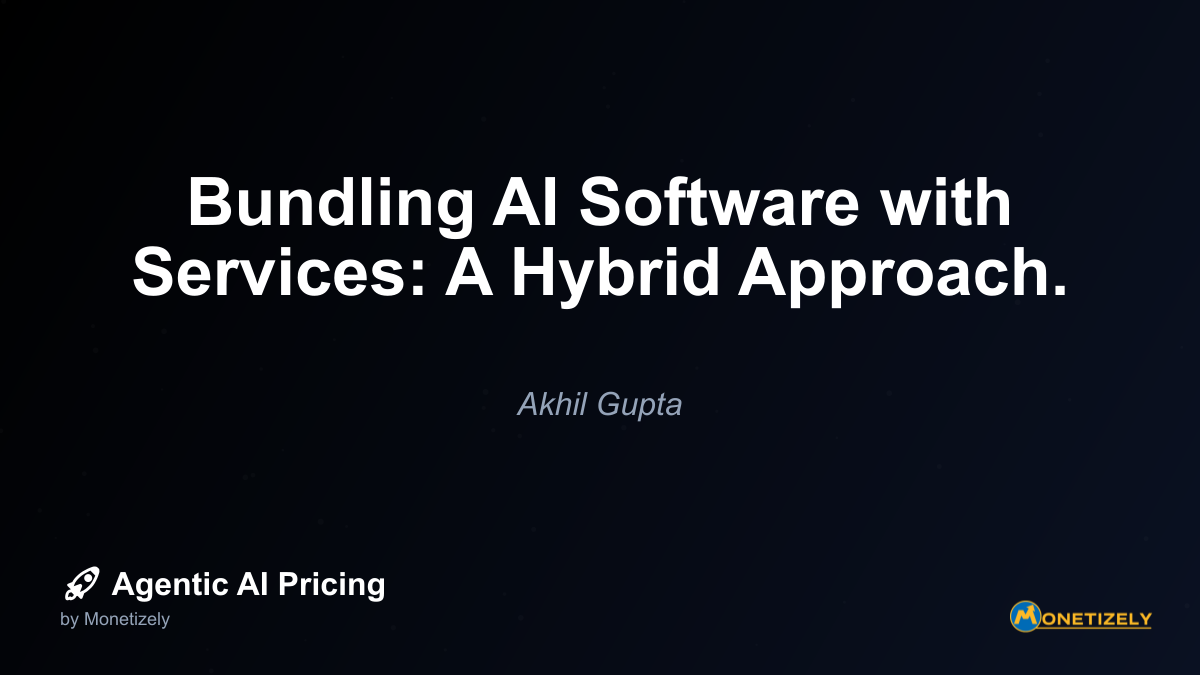· Akhil Gupta · Strategy & Planning · 10 min read
CFO Perspective: Managing AI Spend and Budgeting for Unpredictability.
AI and SaaS Pricing Masterclass
Learn the art of strategic pricing directly from industry experts. Our comprehensive course provides frameworks and methodologies for optimizing your pricing strategy in the evolving AI landscape. Earn a professional certification that can be imported directly to your LinkedIn profile.

Rolling Forecasts and Adaptive Planning
Rather than relying solely on annual budgets, progressive organizations implement rolling forecasts that are updated quarterly or even monthly. This approach allows for continuous refinement based on actual usage patterns and emerging AI opportunities.
Key components of an effective adaptive planning process include:
Establishing usage baselines: Analyze initial consumption patterns to create reference points for future projections.
Scenario modeling: Develop multiple usage scenarios (conservative, expected, aggressive) to understand potential cost ranges.
Regular reforecasting: Update projections based on actual usage data and changing business conditions.
Contingency reserves: Allocate buffer funds specifically for AI cost variability.
According to a recent survey by Deloitte, organizations that implement rolling forecasts for technology expenditures report 30% more accurate budget projections compared to those using traditional annual budgeting alone.
Departmental Allocation Models
As AI adoption spreads across the organization, CFOs must determine how to allocate costs to business units. Several models have emerged:
Centralized AI budget: All AI expenditures managed by a central team (often IT or a dedicated AI center of excellence).
- Pros: Easier to control overall spending, enables strategic prioritization
- Cons: May disconnect business units from cost awareness, potential for bureaucracy
Departmental AI budgets: Each business unit manages its own AI allocation.
- Pros: Creates direct accountability, aligns with value creation
- Cons: Potential for inefficiency, difficult to leverage enterprise-wide discounts
Hybrid models: Core infrastructure centrally funded with usage-based chargebacks.
- Pros: Balances control with flexibility, promotes cost awareness
- Cons: Administrative overhead, potential internal friction over allocations
The most effective approach depends on organizational structure, AI maturity, and corporate culture. Many organizations begin with a centralized model during initial adoption before transitioning to hybrid approaches as AI usage matures.
Innovation Funds and Stage-Gate Processes
To balance innovation with fiscal responsibility, leading organizations establish dedicated AI innovation funds with structured stage-gate processes. This approach allows for controlled experimentation while maintaining financial discipline.
A typical stage-gate process might include:
- Proof of concept (POC) funding: Small allocations ($5,000-$25,000) for initial experimentation
- Pilot funding: Moderate investments ($25,000-$100,000) for successful POCs to validate business impact
- Production funding: Larger allocations for initiatives that demonstrate clear ROI
Each gate requires progressively more rigorous financial analysis and clearer success metrics. This model enables organizations to explore AI’s potential without committing to large-scale implementations prematurely.
Cost Control Strategies for Agentic AI
While budgeting focuses on planning for AI expenditures, cost control addresses managing and optimizing those expenditures once they’re underway. Effective financial leaders implement several strategies to maintain control over variable AI costs.
Committed-Use Discounts and Volume Agreements
Most major AI providers offer significant discounts in exchange for usage commitments. These arrangements can reduce per-unit costs by 20-40% compared to on-demand pricing, providing both savings and improved predictability.
When negotiating these agreements, consider:
- Commitment duration: Longer terms typically yield deeper discounts but reduce flexibility
- Consumption tiers: Understand threshold levels where additional discounts apply
- Rollover provisions: Negotiate the ability to carry unused commitments forward
- Exit clauses: Establish conditions for early termination if business needs change
For example, a healthcare organization might commit to $500,000 in annual AI usage in exchange for a 25% discount, with quarterly true-ups and the ability to roll over up to 10% of unused commitment to the following year.
Usage Monitoring and Alerting Systems
Real-time visibility into AI consumption is essential for effective cost management. Leading organizations implement dashboards and alerting systems that provide:
- Usage tracking by department/project: Granular visibility into consumption patterns
- Anomaly detection: Automated alerts for unusual spikes in usage
- Trend analysis: Visualization of usage patterns over time
- Budget vs. actual comparisons: Real-time visibility into financial performance
These systems enable proactive interventions before costs escalate significantly. For example, a sudden increase in token consumption might indicate an inefficient prompt structure that can be optimized, potentially saving thousands of dollars monthly.
Optimization Techniques and Cost Governance
Beyond monitoring, organizations can implement technical and procedural controls to optimize AI expenditures:
- Prompt engineering: Refining prompts to reduce token consumption without sacrificing output quality
- Model selection: Using smaller, more efficient models for appropriate use cases
- Caching strategies: Storing and reusing common responses rather than regenerating them
- Rate limiting: Implementing usage caps for specific applications or departments
- Approval workflows: Requiring authorization for higher-cost operations
A formal cost governance framework should define:
- Who can access which AI capabilities
- Approval thresholds for different usage levels
- Regular review processes to identify optimization opportunities
- Clear accountability for managing departmental AI expenditures
For example, a financial services firm might allow unrestricted access to smaller language models while requiring director-level approval for using the most advanced (and expensive) models.
Forecasting Strategies for Variable AI Costs
Accurate forecasting is perhaps the greatest challenge CFOs face in managing agentic AI expenditures. Several approaches can improve predictability despite the inherent variability.
Usage Pattern Analysis and Modeling
Historical usage data provides the foundation for more accurate forecasting. By analyzing patterns across different dimensions, financial leaders can develop more nuanced projections:
- Temporal patterns: Identifying daily, weekly, or seasonal fluctuations
- User adoption curves: Modeling how usage grows as employees become more comfortable with AI tools
- Project lifecycle stages: Understanding how consumption evolves from development to production
- Business driver correlation: Connecting AI usage to business metrics (e.g., customer interactions, transaction volume)
For example, a retail organization might discover that AI usage increases 40% during peak shopping seasons, allowing them to incorporate this seasonality into their financial projections.
Cohort-Based Forecasting
As AI adoption spreads across the organization, cohort analysis becomes a powerful forecasting tool. By studying how different groups adopt and utilize AI capabilities, financial leaders can better predict future consumption:
- Department cohorts: Analyzing adoption patterns by business function
- User role cohorts: Understanding how different employee types utilize AI
- Application cohorts: Tracking usage patterns for different AI use cases
This approach allows organizations to develop more accurate forecasts as AI expands to new areas. For instance, if the marketing department’s AI usage stabilized at approximately $1,000 per marketing employee after six months, this pattern can inform projections when similar capabilities are deployed to the customer service team.
Scenario Planning and Sensitivity Analysis
Given the inherent unpredictability of AI consumption, scenario planning becomes essential. Rather than producing a single forecast, financial leaders should develop multiple scenarios with clearly defined assumptions:
- Base case: Expected adoption and usage patterns
- Accelerated adoption: Faster user uptake and higher per-user consumption
- Constrained scenario: Limited adoption or usage restrictions
- Breakthrough case: Identification of high-value use cases driving expanded usage
For each scenario, conduct sensitivity analysis to understand which variables most significantly impact costs. This approach helps organizations prepare for a range of outcomes while identifying the key metrics to monitor as leading indicators.
Financial Governance for Agentic AI
As AI expenditures grow, organizations need robust governance frameworks to ensure appropriate oversight and accountability. Effective governance balances innovation with fiscal responsibility.
Cross-Functional Governance Committees
Leading organizations establish AI governance committees with representation from finance, technology, legal, and business units. These committees typically:
- Review and approve significant AI investments
- Establish policies for AI usage and cost management
- Monitor overall expenditures against budgets
- Prioritize enterprise-wide AI initiatives
- Share best practices across departments
The CFO plays a crucial role on this committee, bringing financial discipline while enabling strategic investments that drive business value.
ROI Frameworks for AI Initiatives
Traditional ROI calculations often struggle to capture AI’s full value, particularly for generative AI applications where benefits may be diffuse or qualitative. Forward-thinking organizations develop more comprehensive evaluation frameworks:
- Direct cost savings: Quantifiable reductions in operational expenses
- Productivity improvements: Time saved multiplied by fully loaded employee costs
- Revenue enablement: Increased sales or customer retention attributable to AI capabilities
- Risk reduction: Decreased likelihood or impact of adverse events
- Strategic positioning: Competitive advantage and market differentiation
These frameworks should acknowledge both quantifiable and qualitative benefits while maintaining appropriate financial rigor. For example, a comprehensive ROI analysis might show that an AI customer service assistant delivers $2M in direct cost savings, $3M in productivity improvements, and significant but less quantifiable benefits in customer satisfaction and retention.
Vendor Management and Contract Optimization
As AI expenditures grow, vendor management becomes increasingly important. Effective financial leaders:
- Consolidate spending with strategic providers to maximize volume discounts
- Negotiate flexible agreements that can adapt to changing business needs
- Implement regular contract reviews to ensure terms remain competitive
- Develop multi-vendor strategies to maintain negotiating leverage
Some organizations are exploring innovative contract structures, such as outcome-based pricing tied to specific business results rather than pure consumption metrics. While still emerging, these approaches can better align vendor incentives with organizational objectives.
Future-Proofing Financial Strategies for AI Evolution
The AI landscape continues to evolve rapidly, with new capabilities, pricing models, and deployment options emerging regularly. Forward-thinking financial leaders are preparing for these changes with adaptable approaches.
For a deeper dive into navigating AI pricing techniques for maximum ROI, our comprehensive CFO’s cheat sheet provides additional insights.Preparing for AI Commoditization and Price Evolution
Historical patterns in technology suggest that AI capabilities will become more affordable over time as competition increases and technologies mature. Financial strategies should anticipate this evolution:
- Avoid long-term commitments at premium price points unless they deliver immediate, significant value
- Build flexibility into vendor contracts to accommodate price reductions
- Regularly benchmark costs against market rates
- Consider the total cost of ownership, including integration, maintenance, and optimization expenses
Organizations that lock themselves into expensive, long-term agreements may find themselves at a competitive disadvantage as more cost-effective options emerge.
Building Internal Capabilities for Financial Management
As AI becomes a core component of business operations, organizations should develop specialized financial management capabilities:
- AI financial analysts with expertise in consumption-based pricing models
- Specialized procurement professionals focused on AI vendor management
- Technical cost optimization specialists who understand the intersection of AI architecture and financial implications
- Business value measurement experts who can quantify AI’s impact
These specialized roles bridge the gap between technical and financial domains, enabling more effective management of AI investments.
Integrating AI Costs into Enterprise Financial Systems
Many organizations initially manage AI expenditures outside their core financial systems, often tracking costs in spreadsheets or vendor-specific dashboards. As AI matures within the organization, integration with enterprise financial systems becomes crucial:
- Automated cost allocation to appropriate cost centers
- Integration with procurement systems for approval workflows
- Incorporation into financial reporting for comprehensive visibility
- Connection to value tracking mechanisms to demonstrate ROI
This integration enables more sophisticated financial management while reducing administrative overhead and improving visibility for stakeholders across the organization.
Conclusion: The CFO as Strategic AI Partner
The rise of agentic AI presents both challenges and opportunities for financial leaders. The variable cost structures and consumption-based pricing models require new approaches to budgeting, forecasting, and cost management. However, these challenges also create opportunities for CFOs to play a more strategic role in technology adoption and value creation.
Successful financial leaders will balance fiscal responsibility with strategic innovation, developing frameworks that enable controlled experimentation while maintaining appropriate governance. They will collaborate closely with technology and business leaders to ensure AI investments deliver measurable value while avoiding unnecessary costs.
As AI continues to transform business operations, the most effective CFOs will:
- Develop new financial competencies specific to AI technologies
- Implement flexible budgeting and forecasting processes that accommodate variability
- Establish robust governance frameworks that balance innovation with control
- Partner with business leaders to identify and prioritize high-value AI use cases
- Negotiate strategic vendor relationships that align with organizational objectives
By embracing these approaches, financial leaders can help their organizations harness AI’s transformative potential while managing the associated financial challenges. The CFO who successfully navigates this new landscape will be positioned not just as a steward of resources but as a strategic partner in driving innovation and competitive advantage.
As one technology CFO recently observed, “AI isn’t just changing how we operate—it’s changing how we think about value creation and measurement. The organizations that get this right will have a significant advantage in the years ahead.”
Co-Founder & COO
Akhil is an Engineering leader with over 16+ years of experience in building, managing and scaling web-scale, high throughput enterprise applications and teams. He has worked with and led technology teams at FabAlley, BuildSupply and Healthians. He is a graduate from Delhi College of Engineering and UC Berkeley certified CTO.
Pricing Strategy Audit
Let our experts analyze your current pricing strategy and identify opportunities for improvement. Our data-driven assessment will help you unlock untapped revenue potential and optimize your AI pricing approach.




